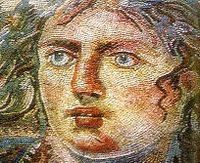Tethys (mythology)

In Greek mythology, Tethys (Greek Τηθύς), daughter of Uranus and Gaia[1] was an archaic Titaness and aquatic sea goddess, invoked in classical Greek poetry but not venerated in cult. Tethys was both sister and wife of Oceanus.[2] She was mother of the chief rivers of the world known to the Greeks, such as the Nile, the Alpheus, the Maeander, and about three thousand daughters called the Oceanids.[3] Considered as an embodiment of the waters of the world she also may be seen as a counterpart of Thalassa, the embodiment of the sea.
Although these vestiges imply a strong role in earlier times, Tethys plays virtually no part in recorded Greek literary texts, or historical records of cults. Walter Burkert[4] notes the presence of Tethys in the episode of Iliad XIV that the Ancients called the "Deception of Zeus", where Hera, to mislead Zeus, says she wants to go to Oceanus, "origin of the gods" and Tethys "the mother". Burkert [5] sees in the name a transformation of Akkadian tiamtu or tâmtu, "the sea," which is recognizable in Tiamat. Alternatively, her name may simply mean "old woman"; certainly it bears some similarity to ἡ τήθη, meaning "grandmother", and she is often portrayed as being extremely ancient (cf. Callimachus, Iamb 4.52, fr. 194).
One of the few representations of Tethys that is identified securely by an accompanying inscription is the Late Antique (fourth century CE) mosaic from the flooring of a thermae at Antioch, now at the Harvard Business School in Boston, Massachusetts[6] after being moved from Dumbarton Oaks.[7] In the Dumbarton Oaks mosaic, the bust of Tethys—surrounded by fishes—is rising, bare-shouldered from the waters. Against her shoulder rests a golden ship's rudder. Gray wings sprout from her forehead, as in the mosaics illustrated above and below.
During the war against the Titans, Tethys raised Hera as her step-child,[8] but there are no records of active cults for Tethys in historic times.
Tethys has sometimes been confused [9] with another sea goddess who became the sea-nymph Thetis, the wife of Peleus and mother of Achilles during Classical times. Some myths imply a second generation relationship between the two, a grandmother and granddaughter.
Indicative of the power exercised by Tethys, one myth[10] relates that the prominent goddess of the Olympians, Hera, was not pleased with the placement of Callisto and Arcas in the sky, as the constellations Ursa Major and Ursa Minor, so she asked her nurse, Tethys, to help. Tethys, a marine goddess, caused the constellations forever to circle the sky and never drop below the horizon, hence explaining why they are circumpolar. Robert Graves interprets the use of the term nurse in Classical myths as identifying deities who once were goddesses of central importance in the periods before historical documentation.[11]
| Greek deities series |
|
|---|---|
| Primordial deities | |
| Titans and Olympians | |
| Chthonic deities | |
| Personified concepts | |
| Other deities | |
| Aquatic deities | |
|
|
Tethys, a moon of the planet Saturn, and the prehistoric Tethys Ocean are named after this goddess.
Contents |
Children of Tethys
- Achelous
- Acheron
- Alpheus
- Amaltheia
- Amphitrite
- Asia
- Asopus
- Callirrhoe
- Calypso
- Catillus
- Cebren
- Cephissus
- Circe
- Clitunno (Roman mythology)
- Clymene
- Clytia
- Crinisus
- Dione
- Doris
- Electra
- Enipeus
- Eurynome
- Inachus
- Lysithea
- Melia
- Meliboea
- Merope
- Metis
- Nilus
- The Oceanids
- Peneus
- Perse
- Pleione
- Rhode
- Scamander
- Styx
- Telesto
- Tiberinus (Roman mythology)
- Tibertus (Roman mythology)
- Tyche
- Volturnus (Roman mythology)
Notes
| Greek deities series |
|---|
|
Primordial deities |
| Titans |
|
The Twelve Titans: |
- ↑ Hesiod. Theogony lines 136, 337 and Bibliotheke, 1.2.
- ↑ Tethys and Oceanus appear as a pair in Callimachus, Hymn 4.17, and in Apollonius, Argonautica 3.244. In Catullus 88, not even Tethys and Oceanus can wash away Gellius' stain of incest: "o Gelli, quantum non ultima Tethys/ nec genitor Nympharum abluit Oceanus." S. J. Harrison, in "Mythological Incest: Catullus 88" The Classical Quarterly New Series, 46.2 (1996), pp. 581-582, points out the irony of Catullus' allusion to the sibling couple in this context.
- ↑ Hesiod. Theogony, 337-70 gives an extensive list of their progeny, reflected in the list appended above.
- ↑ Burkert 1992:92 states that "Tethys is in no way an active figure in Greek mythology".
- ↑ Burkert 1992:93.
- ↑ http://media.www.harbus.org/media/storage/paper343/news/2007/04/02/BakerLibrary/This-Month.From.Baker.Library-2815258.shtml
- ↑ Sara M. Wages, "A Note on the Dumbarton Oaks 'Tethys Mosaic'"Dumbarton Oaks Papers 40 (1986), pp. 119-128. Wages notes a sixth-century Attic vase painted by Sophilos at the British Museum, where Tethys is identified among the guests, that included all of the deities, at the wedding of Peleus and Thetis. She appends a list of other similar, though [unidentified] images from the Greek east as far as Armenia, that can be taken for Tethys.
- ↑ "...the time when Zeus caused Father Kronos to sink beneath the earth and sea. At that time Zeus and Hera lived in the palace of Okeanos and Tethys, who had received the divine children from the hands of Rhea and were keeping them hidden." (Karl Kerenyi, The Gods of the Greeks, 1951: 96, noting Iliad 14.239).
- ↑ even in Antiquity (Burkert 1992:92)
- ↑ Pseudo-Hyginus, Fabulae, 177: "For Tethys, wife of Oceanus, and foster mother of Juno [Hera], forbids its setting in the Oceanus."
- ↑ Robert Graves, The Greek Myths, 24.9, 164.1
Calypso
Argive genealogy in Greek mythology
| Argive genealogy in Greek mythology | |||||||||||||||||||||||||||||||||||||||||||||||||||||||||||||||||||||||||||||||||||||||||||||||||||||||||||||||||||||||||||||||||||||||||||||||||||||||||||||||||||||||||||||||||||||||||||||||||||||||||||||||||||||||||||||||||||||||||||||||||||||||||||||||||||||||||||||||||||||||||||||||||||||||||||||||||||||||||||||||||||||||||||||||||||||||||||||||||||||||||||||||||||||||||||||||||||||||||||||||||||||||||||||||||||||||||||||||||||||||||||||||||||||||||||||||||||||||||||||||||||||||||||||||||||||||||||||||||||||||||||||||||||||||||||||||||||||||||||||||||||||||||||||||||||||||||||||||||||||||||||||||||||||||||||||||||||||||||||||||||||||||||||||||||||||||||||||||||||||||||||||||||||||||||||||||||||||||||||||||||||||||||||||||||||||||||||||||||||||||||||||||||||||||||||||||||||||||||||||||||||||||||||||||||||||||||||||||||||||||||||||||||||||||||||||||||||||||||||||||||||||||||||||||||||||||||||||||||||||||||||||||||||||||||||||||||||||||||||||||||||||||||||||||||||||||||||||||||||||||
|---|---|---|---|---|---|---|---|---|---|---|---|---|---|---|---|---|---|---|---|---|---|---|---|---|---|---|---|---|---|---|---|---|---|---|---|---|---|---|---|---|---|---|---|---|---|---|---|---|---|---|---|---|---|---|---|---|---|---|---|---|---|---|---|---|---|---|---|---|---|---|---|---|---|---|---|---|---|---|---|---|---|---|---|---|---|---|---|---|---|---|---|---|---|---|---|---|---|---|---|---|---|---|---|---|---|---|---|---|---|---|---|---|---|---|---|---|---|---|---|---|---|---|---|---|---|---|---|---|---|---|---|---|---|---|---|---|---|---|---|---|---|---|---|---|---|---|---|---|---|---|---|---|---|---|---|---|---|---|---|---|---|---|---|---|---|---|---|---|---|---|---|---|---|---|---|---|---|---|---|---|---|---|---|---|---|---|---|---|---|---|---|---|---|---|---|---|---|---|---|---|---|---|---|---|---|---|---|---|---|---|---|---|---|---|---|---|---|---|---|---|---|---|---|---|---|---|---|---|---|---|---|---|---|---|---|---|---|---|---|---|---|---|---|---|---|---|---|---|---|---|---|---|---|---|---|---|---|---|---|---|---|---|---|---|---|---|---|---|---|---|---|---|---|---|---|---|---|---|---|---|---|---|---|---|---|---|---|---|---|---|---|---|---|---|---|---|---|---|---|---|---|---|---|---|---|---|---|---|---|---|---|---|---|---|---|---|---|---|---|---|---|---|---|---|---|---|---|---|---|---|---|---|---|---|---|---|---|---|---|---|---|---|---|---|---|---|---|---|---|---|---|---|---|---|---|---|---|---|---|---|---|---|---|---|---|---|---|---|---|---|---|---|---|---|---|---|---|---|---|---|---|---|---|---|---|---|---|---|---|---|---|---|---|---|---|---|---|---|---|---|---|---|---|---|---|---|---|---|---|---|---|---|---|---|---|---|---|---|---|---|---|---|---|---|---|---|---|---|---|---|---|---|---|---|---|---|---|---|---|---|---|---|---|---|---|---|---|---|---|---|---|---|---|---|---|---|---|---|---|---|---|---|---|---|---|---|---|---|---|---|---|---|---|---|---|---|---|---|---|---|---|---|---|---|---|---|---|---|---|---|---|---|---|---|---|---|---|---|---|---|---|---|---|---|---|---|---|---|---|---|---|---|---|---|---|---|---|---|---|---|---|---|---|---|---|---|---|---|---|---|---|---|---|---|---|---|---|---|---|---|---|---|---|---|---|---|---|---|---|---|---|---|---|---|---|---|---|---|---|---|---|---|---|---|---|---|---|---|---|---|---|---|---|---|---|---|---|---|---|---|---|---|---|---|---|---|---|---|---|---|---|---|---|---|---|---|---|---|---|---|---|---|---|---|---|---|---|---|---|---|---|---|---|---|---|---|---|---|---|---|---|---|---|---|---|---|---|---|---|---|---|---|---|---|---|---|---|---|---|---|---|---|---|---|---|---|---|---|---|---|---|---|---|---|---|---|---|---|---|---|---|---|---|---|---|---|---|---|---|---|---|---|---|---|---|---|---|---|---|---|---|---|---|---|---|---|---|---|---|---|---|---|---|---|---|---|---|---|---|---|---|---|---|---|---|---|---|---|---|---|---|---|---|---|---|---|---|---|---|---|---|---|---|---|---|---|---|---|---|---|---|---|---|---|---|---|---|---|---|---|---|---|---|---|---|---|---|---|---|---|---|---|---|---|---|---|---|---|---|---|---|---|---|---|---|---|---|---|---|---|---|---|---|---|---|---|---|---|---|---|---|---|---|---|---|---|---|---|---|---|---|---|---|---|---|---|---|---|---|---|---|---|---|---|---|---|---|---|---|---|---|---|---|---|---|---|---|---|---|---|---|---|---|---|---|---|---|---|---|---|---|---|---|---|---|---|---|---|---|---|---|---|---|---|---|---|---|---|---|---|---|---|---|---|---|---|---|---|---|---|---|---|---|---|---|---|---|---|---|---|---|---|---|---|---|---|---|---|---|---|---|---|---|---|---|---|---|---|---|---|---|---|---|---|---|---|---|---|---|---|---|---|---|---|---|---|---|---|---|---|---|---|---|---|---|---|---|---|---|---|---|---|---|---|---|---|---|---|---|---|---|---|---|---|---|---|---|---|---|---|---|---|---|---|---|---|---|---|---|---|---|---|---|---|---|---|---|---|---|---|---|---|---|---|---|---|---|---|---|---|---|---|---|---|---|---|---|---|---|---|---|---|---|---|---|---|---|---|---|---|---|---|---|---|---|---|---|---|---|
|
|||||||||||||||||||||||||||||||||||||||||||||||||||||||||||||||||||||||||||||||||||||||||||||||||||||||||||||||||||||||||||||||||||||||||||||||||||||||||||||||||||||||||||||||||||||||||||||||||||||||||||||||||||||||||||||||||||||||||||||||||||||||||||||||||||||||||||||||||||||||||||||||||||||||||||||||||||||||||||||||||||||||||||||||||||||||||||||||||||||||||||||||||||||||||||||||||||||||||||||||||||||||||||||||||||||||||||||||||||||||||||||||||||||||||||||||||||||||||||||||||||||||||||||||||||||||||||||||||||||||||||||||||||||||||||||||||||||||||||||||||||||||||||||||||||||||||||||||||||||||||||||||||||||||||||||||||||||||||||||||||||||||||||||||||||||||||||||||||||||||||||||||||||||||||||||||||||||||||||||||||||||||||||||||||||||||||||||||||||||||||||||||||||||||||||||||||||||||||||||||||||||||||||||||||||||||||||||||||||||||||||||||||||||||||||||||||||||||||||||||||||||||||||||||||||||||||||||||||||||||||||||||||||||||||||||||||||||||||||||||||||||||||||||||||||||||||||||||||||||||
References
- Burkert, Walter The Orientalizing Revolution: Near Eastern Influence on Greek Culture in the Early archaic Age (Harvard University Press) 1992, pp 91-93.
- Theoi.com: Tethys
|
|||||||||||||||||||||||||||||||||||||||||||||||||||||||||||||||||||||||||||